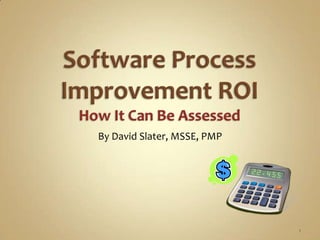Assessing Process Improvement ROI
- 1. Software Process Improvement ROIHow It Can Be AssessedBy David Slater, MSSE, PMP1
- 2. ObjectivesDiscuss options for determining process ROIExplain the methods employed in this ROI modelPresent sample scenariosRecommend an approach for monitoring results2Note: The ROI principles presented here can be used to assess other process initiatives such as ITIL.
- 3. What factors affect Project Performance?FactorsProductivity ’āĀQuality’āĀPredictability’āĀRisk’āĀMetricsFunction Points, Lines of CodeDefects, usefulnessSchedule, costSurprises, failures3
- 4. What is the Opportunity?4Level 5Optimizing Defect Prevention
- 5. Technology Change Mgt
- 6. Process Change MgtLevel 4Level 3Managed Quantitative Process Mgt
- 7. Software Quality MgtDefined Process Focus
- 10. Integrated S/W Management
- 13. Peer ReviewsLevel 4 to Level 5Productivity:2.9x Level 4Rework: 3% reductionLevel 2Level 3 to Level 4Productivity:1.9x Level 3Rework: 5% reductionRepeatable Requirements Management
- 14. Project Planning
- 15. Project Tracking & Oversight
- 18. Configuration ManagementLevel 2 to Level 3Productivity:2x Level 2Rework: 11% reductionSEI Capability Maturity ModelLevel 1Initial NoneLevel 1 to Level 2Productivity:Level 1 undefinedRework: Level 1 undefined
- 19. What is the Opportunity?5SEI Capability Maturity ModelHighLevel 5Low Variation
- 20. Low Cost
- 22. High Quality
- 23. Fast Cycle TimeMaturityLevel 1Wide Variation
- 24. High Cost
- 25. Low Productivity
- 26. Low Quality
- 27. Slow Cycle TimeLowLevel 1 to Level 5Productivity Increase:11.02 x Level 1Rework Reduction: 82% less than Level 1
- 28. Methods for Determining ROIUse metrics collected by your businessDetermine your estimate for improvement
- 29. If metrics arenŌĆÖt availableŌĆ”.Use metrics from industry studiesFactor up or down based on your confidenceApply factors chosen to percent of annual budget covering new process/tools6Coverage Examples
- 30. Sample ROI ScenarioFive year ROI period, $65M budget, 3% growthAve. burdened labor rate of $116/HourFull implementation and support costs includedBenefits from productivity improvement and rework reduction onlyCost penalty for adoption learning curve appliedBenefits reduced by risk factorsRollout schedule variance
- 33. Three ROI ScenariosModeled optimistic, likely, worst case scenariosOnly varied budget coverage factors ŌĆō all other variables are the same8
- 34. Optimistic Scenario9Return on InvestmentNPV: $27,126,008IRR: 28%Breakeven: $11,344,926
- 35. Likely Scenario10Return on InvestmentNPV: $22,903,305IRR: 25%Breakeven: $10,163,869
- 36. Worst Case Scenario11Return on InvestmentNPV: $18,680,603IRR: 20%Breakeven: $8,982,812
- 37. ROI Model ŌĆō Variables12
- 38. Benefit and Cost Categories13
- 39. ROI Measures14
- 40. ROI Progress Must Be TrackedDetermine metricsProductivity
- 41. Rework
- 42. Quality
- 43. Predictability
- 44. RiskImplement a processMetric collection and compliance
- 45. Metric analysis
- 47. Sr. Management review and guidance15
- 48. Thank YouSoftware Process Improvement ROIHow It Can Be AssessedBy David Slater, MSSE, PMP16















